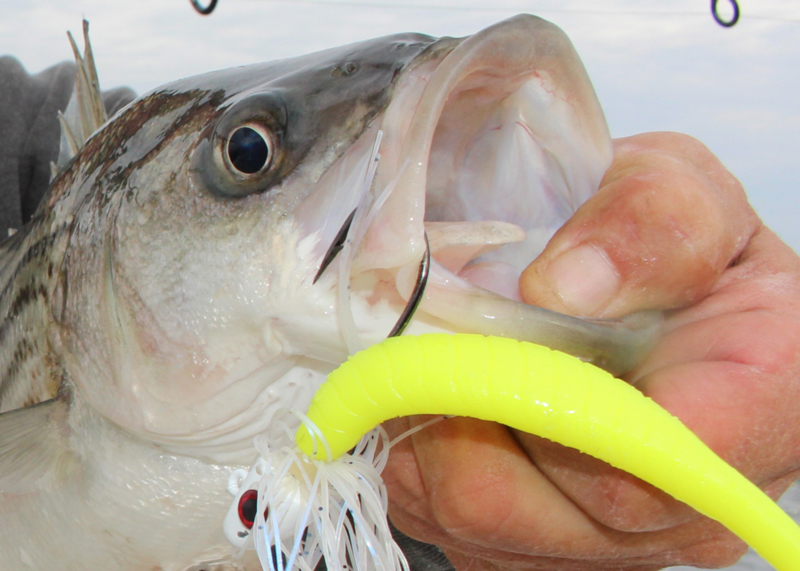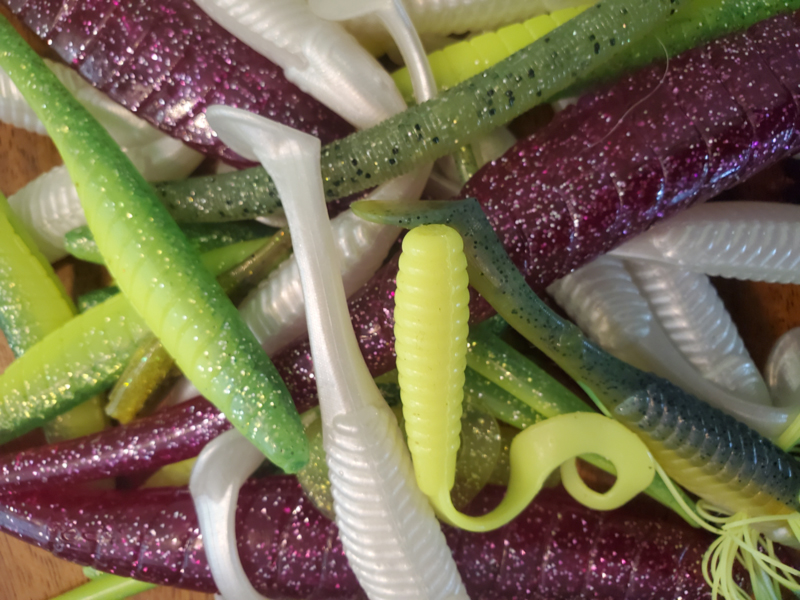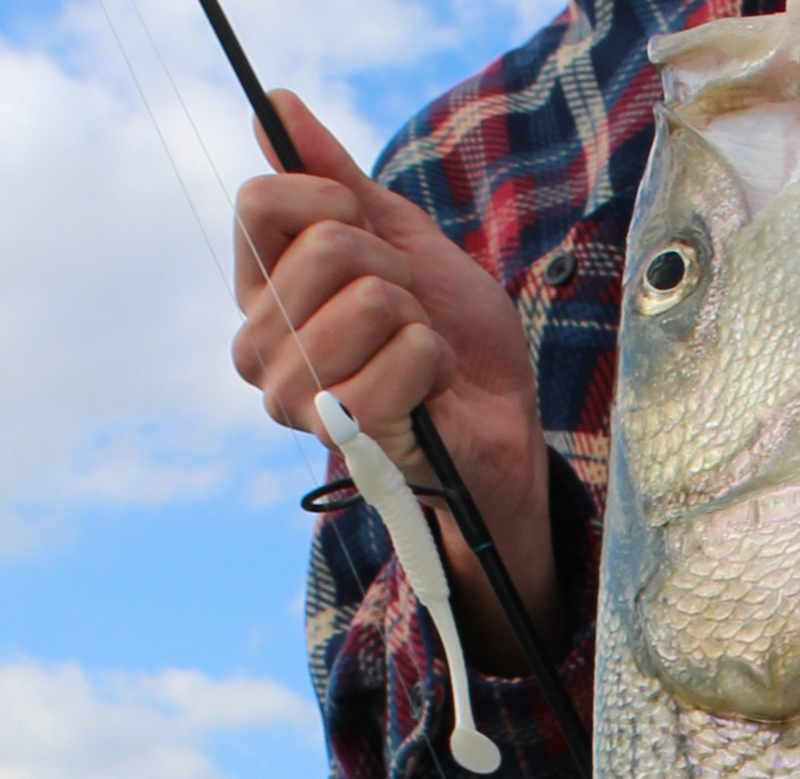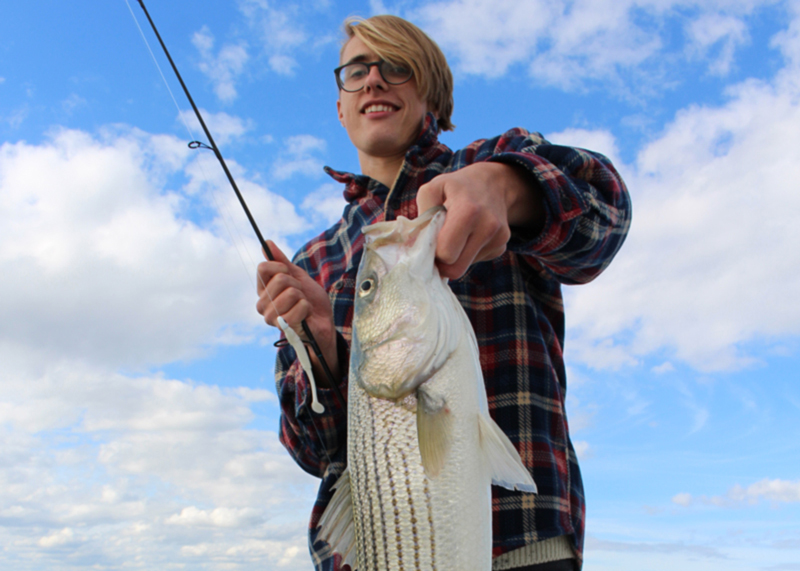When it comes to light tackle jigging, many seasoned Chesapeake Bay anglers take the basics for granted. And if you grew up jigging all the time it’s no wonder. The elemental motions, concepts, and decisions come naturally after a certain amount of experience. But to a new angler, trying to feel a half ounce of lead dressed with a plastic tail touch bottom can seem impossible. Selecting the right jigging cadence can be a mystery. And trying to catch fish can be downright frustrating, even when the reports have adjectives like “fire” and “epic” in them.

If you’re a jigging sharpie, you might want to flip these pages before you get bored. Or, who the heck knows, maybe you’ll pick up a new tip or two. Either way, we’re about to get down to the bare-knuckle basics of jigging so all the beginner anglers out there can get in on the action.
What Is Jigging?
Jigging can mean about 1000 different things in the world of fishing, but it all boils down to moving your rod tip to impart action to a lure or bait, thus making it look alive and frisky to the predators you’re trying to catch. It’s a huge topic with applications ranging from bass to bluefin tuna. In order to examine the basics in detail, for the purposes of this article we’re going to ignore the 999 other forms of jigging and stick with light tackle jigging for rockfish with soft plastics on jigheads, only.
What Is Light Tackle?
The answer to this question lies in the eye of the beholder. To me, personally, it’s using a six- to seven-foot light, light-medium, or medium power (ratings can vary by manufacturer as there are no standards for what constitutes rod power) fast-action rod with a 3500 series or thereabouts spinning reel, spooled with braid in the 10- to 15-pound test range and topped off with 20- to 25-pound fluorocarbon leader.
If you grew up tossing crappie jigs on ultra-light gear with four-pound test, rigs of this size will feel ginormous. Conversely, if you grew up cranking on a 50-wide clamped to a broomstick they’ll feel ridiculously light. Again: just what “light tackle” means depends on who you are and how you fish. So, how’s a rank beginner supposed to gauge it? The above guidelines will give you a starting point, and remember that if a rod is rated for more than 15-pound test it’s probably too heavy for most light tackle jiggers. If it’s rated for less than eight-pound test, it’s probably too light. Either way, a fast action is a must for this type of fishing, and rod length is more a matter of personal preference than anything else.
When it comes to reels, 2500 is getting pretty small and 4500 is getting pretty large, so going in-between is usually a good move. And as far as line goes, braid heavier than 17-pound test begins to become overkill and changes the jig’s sink rate. Once more, however, I’ll point out that personal preference counts and there really aren’t any hard rules when it comes to fishing — I’m sure there are some jigging kings out there using 20-pound test, and just as many using 10-pound test, who are getting by just fine. Note: many (myself included) would call braid line a must-have for this type of fishing, thanks to its enhanced sensitivity and zero-stretch qualities.
What Are Soft Plastic Jigs?

There are a million and one soft plastic jigs of all shapes, sizes, and color patterns which can be threaded onto the hook of a lead jighead. At a basic level, however, for this type of fishery most anglers stick with plastics between four and seven inches, with straight or paddle-tails. Twister tails get some play from jiggers, too. For beginner anglers paddle-tails are often the best choice since they “swim” on their own and don’t need a ton of additional angler input to catch fish.
Basic colors are white and chartreuse, with darks like purple or brown coming into play in low-light conditions. There will be days when, for whatever reason, orange, Electric Chicken, pink, or some other oddball choice out-catches everything else. But as a general rule of thumb it’s hard to go wrong with plain old white or chartreuse.
The bottom line: a five-inch white paddle-tail is a great choice for newly minted anglers. If that’s what you’re using and you’re confident fish are around but you’re not getting bites, that means it’s time to start experimenting with other offerings until you find what color or pattern they want.

What Are Jig Skirts?
Many jiggers like to add rubber or silicon skirts to their jigs (as seen on the jig in the first photograph on this webpage). These present a larger profile than the straight plastic tail, pulse and move in the water to add action and allure to your jigs, and also allow you to add some color-contrast. As a general rule of thumb, skirts are a good addition to plastic jigs. You will find times, however, when skirts make little difference or can even hinder the bite.
Just like having different color and size jigs add to your arsenal of options, skirts give you one more thing to try when the bite’s slow or nonexistent. So, it’s a good idea to keep some skirted jig heads handy (you can buy heads with skirts or buy them separately and put them on the heads yourself). If you’re not getting bites give them a try, and if you’re using a skirted head but going bite-less, try ditching that skirt and see if the fish want a plainer offering.
What Are Jig Heads?
Those soft plastics get threaded onto a hook with a lead head. These heads also come in many shapes and sizes, and most will work just fine. The tough part of choosing the right jig head is finding the correct weight. The critical element is choosing the lightest head with which you can still detect bottom. Bouncing your jig along bottom or starting there and then jigging up through the water column is often necessary in order to catch those fish, so if you can’t detect bottom, you probably need to up-size the head you’re using.
Here are some basic guidelines: when casting into the shallows a quarter ounce is probably all you’ll need. In water to 10 or so feet deep a half ounce is a good choice. In 15 to 20 feet, three-quarters of an ounce to one ounce is appropriate. And in deeper water, you may need to go to an ounce and a half or more. Remember that current or wind will commonly mean you need more weight to maintain sensitivity and control.
Why not just use a big, heavy head all the time? First, because you’ll likely dredge along the bottom, which not only won’t catch fish but will also get you snagged a lot more often. Second, at different times the fish will react better or worse to different sink-rates. Obviously, heavier heads sink faster. And there will be plenty of times when a slower flutter towards bottom is exactly what the fish want.
How Do You Jig?
We’re going to first break down jigging styles into two: vertical, and horizontal. Vertical jigging is almost always done from a boat, and involves dropping your jig down to the fish’s depth and jigging with a simple up-and-down motion. It’s usually most effective when the boat is passing or holding directly over the fish. Much of the time — although not 100 percent of the time — this form of jigging works better with a spoon or some other offering as opposed to a soft plastic. So for the purposes of this article, we’re not going to dwell on it.

Horizontal jigging takes place when you cast out the lure, let it sink to the depth of the fish or to the bottom, then jig as you retrieve it. Here are some critical points to keep in mind about horizontal jigging:
- Snap the tip up quickly by rotating your wrist, as opposed to lifting your entire arm.
- After snapping the tip up, drop it back down while simultaneously cranking on the reel. You want the jig to sink as naturally as possible, but you also have to maintain minimal tension on the line because if a fish hits when the line is slack you’ll never even know it.
- As you drop the rod tip down and crank, if you feel a bump before the jig hits bottom you know a fish has struck — immediately rear back with the rod tip to set the hook.
- The vast majority of your hits will come as the jig is sinking, not on the snap.
- Vary cranking speed until you figure out how active the fish want it. Remember that in warmer water they’ll likely want a faster, more active retrieve. In cool water, they’ll likely react better to a slower retrieve.
- When you know fish are sitting on or near bottom, bounce the jig along and wait to feel it hit bottom every time, before snapping the tip up again.
- When fish are suspended it’s best for beginners to cast out and let the jig hit bottom, then retrieve at a steady pace. This way at some point, the jig will pass through the proper depth. When you get some experience under your belt, you’ll be able to better judge what depth the jig is at and keep it in the strike zone for longer periods of time.
- Eyeball your jig after every cast and make sure the plastic is pushed all the way up against the jighead, not hanging from the hook.
How To Jig Around Structure
Much of the time rockfish will orient to structure. This can range from the pilings of the Bay Bridge or the CBBT, to rip-rap on a shoreline, to underwater humps and ridges. As a general rule, when fish are around structure you’ll want to cast your jig as close as possible to it. But there’s a conundrum: the closer you cast to rocks and pilings, the more often you’ll snag and break off. Don’t let this worry you, it’s just part of fishing. In fact, if you never snag and break off, you’re probably not casting where the fish are.
After snagging on one cast, you may want to try reeling a bit faster and/or keeping your rod tip a bit higher to keep your jig ever so slightly off the structure itself, or off the bottom. But don’t stop aiming for it. There will be times when casts that land within two feet of the target get hit every time, but if your jig lands beyond that range it won’t get so much as a sniff.
Is that it? Is light tackle jigging for rockfish with soft plastic really that simple? Nope, of course not. As with all forms of fishing there are countless variables, details, and nuances that come into play. But these basics are what every beginner angler needs to know to enjoy some success out on the water. And if you apply them, hopefully, you’ll catch more, bigger fish.
-By Lenny Rudow